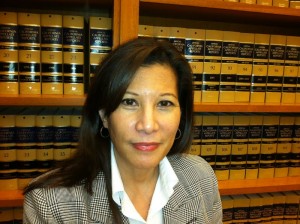I see a developing trend. I see movement, where our numbers are increasing in diversity on the bench in terms of seeing judges that are representative of the state of California and our diverse population.
As I've been to different law schools and graduation ceremonies and see the classes accepting their diplomas, it's clear we're moving toward the tremendous diversity that reflects what California's fabric really is.
Scott Shafer
Looking at the demographics of California from the 2010 census, you see 40% white, 38% Latino, 13% Asian, 6% black. But the make-up of the judiciary isn't anything like that. So some people ask: why's it's taking so long?
Tani Cantil-Sakauye
Pure speculation here, but you have to be a lawyer for 10 years before you become a judge. We know that law schools have had a past history of being primarily male, so we're only now beginning to see more diversity from graduating classes.
Those diverse students are going into the bar, but they need 10 years minimum experience before they can apply to be a superior court judge. Just at UC Davis last year, for example, 4 out of 10 members of the graduating class are Latino, African American, or Asian.
So it's incredible when you think of the change we're seeing in how students look. That will translate into membership in the bar, and eventually into representation on the bench.
Scott Shafer
On the gender question, 70% of California judges are men. Why is that so skewed still?
Tani Cantil-Sakauye
That's a good question. Because we also know that in the past few years females are taking the state bar at a slightly higher rate than males. And females show a bar passage rate at a slightly higher rate than their male counterparts.
Scott Shafer
So why is there a lag in terms of females on the bench?
Tani Cantil-Sakauye
I think we're seeing a change. Keep in mind, when you see 70% of the judges are male, it would be interesting to find out how long many of those judge have been on the bench. Because when you look at the appointments made by governors Davis, Schwarzenegger and Brown, you're seeing more female representation. You're beginning o see more of a critical mass of women who are available for the bench.
Scott Shafer
Riverside County, for example, is half Latino. San Bernardino, similar demographics. Raquel Marquez, was recently appointed in Riverside County, and she is the first Latina to sit on the bench there. What do you make of that?
Tani Cantil-Sakauye
Like all firsts, it's a foreshadowing of many more. I think this governor has shown incredible foresight in on a bench representative of California.
Scott Shafer
When I talked to Judge Marquez, she said that when someone is before you in court, their race, gender and sexual orientation don't matter. In other words justice is blind. So why does it matter if the judiciary is diverse?
Tani Cantil-Sakauye
I think it matters because a healthy society requires qualified and impartial judges. And that requires a public trust and confidence in the them. A component of that in the law, in the judges that follow and establish the rule of law, is that they understand and look like you, and when you come to court, it's someone who understands and has a similar lens, at least of the facts.
Now the rule of law is truly colorblind, but in terms of how you see and weigh the facts, it's important for not only public trust and confidence, but for an interpretation of those facts.
Scott Shafer
Because where one comes from impacts to a certain extent how one sees a set of facts?
Tani Cantil-Sakauye
I think that's true. But when I talk about diversity, I don't mean it only in the sense of ethnicity race and gender. It also has to do with culture, experience and what kind of law you practiced before you came to the bench. Certainly we saw in Governor Schwarzenegger's appointments a variety of folks from all disciplines and aspects of the law.
Scott Shafer
Most governors tend to lean toward prosecutors when they pick judges. When I look at Governor Brown's first batch of 17 appointees, though, 10 of them were public defenders or have some public defender experience. What do you think of that?
Tani Cantil-Sakauye
I think Governor Schwarzenegger also appointed a fair number of criminal defense lawyers, maybe not public defenders. I think it's good for the balance of California.
Scott Shafer
Is coming from a defense or prosecuting background predictive of the kind of judge one is going to be?
Tani Cantil-Sakauye
I don’t' think so. I know people think that might be the obvious answer. But when you come to the bench, you shed your partisanship. I'm not saying the first couple of years isn't an adjustment, because you have to now sit as a neutral fact finder. But you put aside that advocacy when you come to the bench. Your lens is colored by your experience, but nevertheless you aren't taking a position on a case, you don't pre-judge it.
Scott Shafer
How high a priority do you think diversity should be when choosing a judge?
Tani Cantil-Sakauye
I think, when you look at these numbers, it should be a strong factor that rates highly among all the other factors. It should never be a factor that overrides substantive merit and demeanor and objectivity, but when all those things are equal, it's important to look to diversity.
